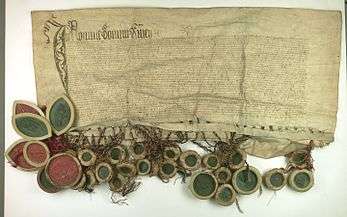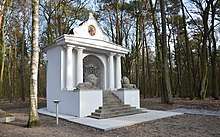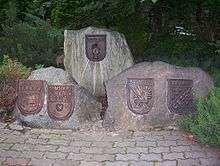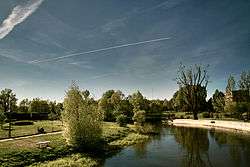Brodnica
Brodnica [brɔdˈɲit͡sa] (![]()
Brodnica | |
|---|---|
Market Square | |
 Flag  Coat of arms | |
 Brodnica  Brodnica | |
| Coordinates: 53°15′35″N 19°23′44″E | |
| Country | |
| Voivodeship | |
| County | Brodnica County |
| Gmina | Brodnica (urban gmina) |
| Established | 13th century |
| Town rights | 1298 |
| Government | |
| • Mayor | Jarosław Radacz |
| Area | |
| • Total | 22.87 km2 (8.83 sq mi) |
| Population (2014) | |
| • Total | 28,574 |
| • Density | 1,200/km2 (3,200/sq mi) |
| Time zone | UTC+1 (CET) |
| • Summer (DST) | UTC+2 (CEST) |
| Postal code | 87–300 to 87–302 |
| Area code(s) | +48 56 |
| Car plates | CBR |
| Climate | Dfb |
| Website | http://www.brodnica.pl |
Brodnica is the capital of the district whose present quarter Michałowo, a settlement mentioned as early as in 1138 and then in 1240 as castrum Michałowo, hides relics from Neolithic era. As it is confirmed in old documents Michałowo was the capital of the Masovian Castellany. The town was chosen owing to its good position on the Drwęca (on the trade route leading from Masovia to Prussia) and a customs house between Dobrzyń and Chełmno Land (mentioned in 1252).
History


The first reference to the town of Brodnica dates from 1263. In 1285–1370 the construction of the Gothic Church of St. Catherine took place. Brodnica received town privileges in 1298. In 1440, the town was one of the founding members of the Prussian Confederation, which opposed Teutonic rule,[1] and upon the request of which King Casimir IV Jagiellon reincorporated the territory to the Kingdom of Poland in 1454. In May 1454 the town pledged allegiance to the Polish King in Toruń.[2] After the end of the Thirteen Years' War, the Teutonic Knights renounced claims to the town, and recognized it as part of Poland. It became a royal town of the Polish Crown,[3] administratively located in the Chełmno Voivodeship. A favourable location on the intersection of important routes used for transportation of different goods (wood, fish, furs, animal skin, grain, wool) accelerated the development of the town, making it an important trading centre, the status still reflected in the number of well-preserved granaries along the Drwęca. In the Teutonic state Brodnica was the seat of the Commander: in the Polish Republic it was the capital of the district starosty, and the former Commander's lands were then royal property. Between 1486 and 1604 the town belonged to the Działyński family, then between 1604 and 1625 to Anna Vasa of Sweden who was the royal sister of Sigismund III Vasa, King of Poland, Lithuania, and Sweden. In later years it was the property Queen Cecily Renata, Chancellor Jerzy Ossoliński, Queen Maria Casimira, and Marshal Franciszek Bieliński.
Brodnica was annexed by the Kingdom of Prussia in 1772, during the First Partition of Poland, but in 1807, during the Napoleonic Wars, Brodnica became part of the Duchy of Warsaw. Between 1815–1920 Brodnica was again under a Prussian administration as part of the Prussian-led German Empire in 1871. After 1785, the Prussians dismantled the Brodnica Castle, preserving only the tower, which is currently the highest Gothic tower in Poland east of the Vistula, and serves as a museum and a watchtower.
The 19th century saw 20 thousand Polish soldiers interned after the failure of the November Uprising (1830–1831) and many townspeople and noblemen involved in the January Uprising (1863). It is in Brodnica region too that Masovian insurgents sought refuge from Russian persecution after the failure of the January Uprising. Bank Spółdzielczy w Brodnicy, which is the oldest continuously operating Polish bank, was established in 1862.[3] In 1873 a Polish philomath organization was founded in the local gymnasium, which activity ended in 1901 due to Germany's anti-Polish policies.[3]
Between 1886 and 1910 Brodnica received railway connections with Działdowo, Grudziądz, Iława, Sierpc and Jabłonowo Pomorskie, which made it an important railway junction and triggered the industrial progress. In the 19th century the Chełmno Land (and Brodnica in particular) was a refuge of Polish patriots who contributed greatly to social, cultural and economic life of the region, like Ignacy Łyskowski.

In January 1920, after the end of World War I and the Treaty of Versailles, Brodnica was reintegrated with Poland, which regained independence.[3] On 18 August 1920 the town was the site of a Polish victory over the invading Soviets in the Battle of Brodnica during the Polish–Soviet War. In the 1920s the town was visited by highest Polish dignitaries: Prime Minister Wincenty Witos, Marshal Józef Piłsudski and President Stanisław Wojciechowski.[3]
During the occupation of Poland (World War II), in 1939, Germans carried out mass arrests of local Poles, who were later murdered in the area or deported to Nazi concentration camps.[3][4] Some of these Poles were murdered in Skrwilno between 15 October and 15 November 1939 and in Brzezinki in October 1939.[5] The interwar principal of the local high school, Klemens Malicki, was among the Polish principals and teachers murdered in the Oranienburg concentration camp as part of the Intelligenzaktion Pommern.[6] In 1944, the Germans also established a subcamp of the Stutthof concentration camp, intended for female prisoners.[7] The German occupation ended in January 1945.
Climate
Climate in this area has mild differences between highs and lows, and there is adequate rainfall year-round. The Köppen Climate Classification subtype for this climate is "Cfb". (Marine West Coast Climate).[8]
| Climate data for Brodnica | |||||||||||||
|---|---|---|---|---|---|---|---|---|---|---|---|---|---|
| Month | Jan | Feb | Mar | Apr | May | Jun | Jul | Aug | Sep | Oct | Nov | Dec | Year |
| Record high °C (°F) | 15.0 (59.0) |
16.6 (61.9) |
24.1 (75.4) |
30.0 (86.0) |
34.0 (93.2) |
36.2 (97.2) |
38.2 (100.8) |
37.7 (99.9) |
34.1 (93.4) |
27.3 (81.1) |
20.2 (68.4) |
16.8 (62.2) |
38.2 (100.8) |
| Average high °C (°F) | 2.3 (36.1) |
2.9 (37.2) |
8.3 (46.9) |
13.6 (56.5) |
19.4 (66.9) |
22.1 (71.8) |
24.6 (76.3) |
24.5 (76.1) |
19.3 (66.7) |
13.9 (57.0) |
6.7 (44.1) |
3.2 (37.8) |
13.4 (56.1) |
| Daily mean °C (°F) | −1.2 (29.8) |
−0.7 (30.7) |
4.0 (39.2) |
9.8 (49.6) |
14.9 (58.8) |
18.2 (64.8) |
20.1 (68.2) |
19.8 (67.6) |
15.3 (59.5) |
9.9 (49.8) |
4.4 (39.9) |
0.2 (32.4) |
9.6 (49.3) |
| Average low °C (°F) | −4.6 (23.7) |
−4.3 (24.3) |
−0.3 (31.5) |
6.0 (42.8) |
10.3 (50.5) |
14.3 (57.7) |
15.5 (59.9) |
15.1 (59.2) |
11.3 (52.3) |
5.9 (42.6) |
2.1 (35.8) |
−2.8 (27.0) |
5.7 (42.3) |
| Record low °C (°F) | −28.5 (−19.3) |
−27.6 (−17.7) |
−21.3 (−6.3) |
−6.8 (19.8) |
−3.0 (26.6) |
1.1 (34.0) |
4.7 (40.5) |
3.0 (37.4) |
−3.8 (25.2) |
−6.9 (19.6) |
−15.2 (4.6) |
−22.4 (−8.3) |
−28.5 (−19.3) |
| Average precipitation mm (inches) | 25 (1.0) |
23 (0.9) |
30 (1.2) |
38 (1.5) |
45 (1.8) |
62 (2.4) |
70 (2.8) |
58 (2.3) |
35 (1.4) |
39 (1.5) |
37 (1.5) |
30 (1.2) |
492 (19.4) |
| Average precipitation days | 14 | 12 | 11 | 9 | 11 | 12 | 13 | 13 | 9 | 12 | 14 | 12 | 142 |
| Average relative humidity (%) | 81 | 82 | 75 | 68 | 63 | 68 | 70 | 72 | 74 | 77 | 80 | 82 | 74 |
| Mean monthly sunshine hours | 56 | 67 | 118 | 179 | 230 | 237 | 236 | 229 | 171 | 122 | 55 | 40 | 1,740 |
| Source: Polish Central Statistical Office (closest city on record | |||||||||||||
Location
| Year | Number | |
|---|---|---|
| 1772 | 1,283 | in 228 households (Feuerstellen)[9] |
| 1783 | 1,853 | with the garrison (315 persons belonging to two squadrons of a hussar regiment founded in 1773), mostly Lutherans, 27 Jews[10] |
| 1807 | 2,113 | [9] |
| 1816 | 1,994 | [9] |
| 1826 | 2,669 | [9] |
| 1831 | 2,585 | mostly Germans[11] |
| 1875 | 5,454 | [12] |
| 1880 | 5,801 | [12] |
| 1890 | 6,122 | incl. 2,587 Protestants, 3,048 Catholics and 480 Jews (2,000 Poles)[12] |
| 1905 | 7,217 | incl. 2,702 Protestants and 318 Jews[13] |
| 1931 | 8,521 | approx. 800 Germans[14] |
| 2006 | 32,588 | |
| 2010 | 27,731 | |
| 2014 | 28,574 | |
Brodnica is located in the Kuyavian-Pomeranian Voivodeship on an important route transit over the small river Drwęca, about 48 kilometres (30 miles) south-east of Grudziądz, 90 kilometres (56 miles) south-west of Olsztyn and 98 kilometres (61 miles) south of Elbląg.
Points of interest
Worth noting is the War cemetery in Brodnica established by the Germans during the World War I. 15 November saw a burial of 25 German soldiers killed in the Russian offensive. In 1920 31 Polish soldiers killed during the battle of Brodnica with the Bolsheviks on 18 August were laid to rest here. In 1943 German soldiers who died in the local hospital together with those who lost their lives on 21 January 1945 during the Soviet offensive were put in the ground. A curiosity is that the Red Army soldiers who died on the same day were buried here as well. It is also a burial place for UB people notorious for waging war with Polish anti-communist partisans after 1945.
Sport in Brodnica
The sports teams in the city include the football club Sparta Brodnica,[15] the handball MKS Brodnica club,[16] the Karate Shotokan Brodnica club,[17] the Aikido Brodnicka Akademia Aikido club,[18] the boxing Klub Bokserski Gladiator Brodnica,[19] and the MMA Fight Team MMA Brodnica.[20]
Music in Brodnica
Musicians
Sebastian Kuchczynski – (born 9 August 1986 in Brodnica) is a drummer, composer and arranger. He Graduated from Berklee Collage of Music in Boston, Master's degree, 2017. He is an influential jazz, hip hop, funk and pop drummer. He is a member of bands such as "Radiostatik", "Schmidt Electric", "Ola Trzaska" etc. He also plays with George Garzone, Zbigniew Namysłowski and Maciej Sikała.
International relations
Twin towns – Sister cities

Brodnica is twinned with:








People who were born or lived in Brodnica and Brodnica County
- Martin Truchseß von Wetzhausen – Grand Master of the Teutonic Knights
- Simon Syrenius – Polish botanist and academic
- Anna Vasa of Sweden – Swedish princess made starosta of Brodnica in 1605 by Sigismund III Vasa
- Wojciech Dębołęcki – Polish monk, writer and composer
- Paul von Krause – German jurist and politician
- Robert Garrison – German film actor
- Stanisława Walasiewicz – Polish athlete, who became a women's Olympic champion.
- Jan Zumbach – Polish fighter pilot who became an ace during the Second World War
- Małgorzata Birbach – Polish long-distance runner
- Łukasz Fabiański – Polish footballer
- Jakub Wawrzyniak – Polish footballer
- Robert Kłos – Polish footballer
- Jakub Zabłocki – Polish footballer
- Daniel Trojanowski – Polish rower
- Patryk Kuchczyński – Polish team handball player
Gallery
- Old Town
- Market Square (Duży Rynek) filled with colourful historic townhouses
.jpg) Our Lady Queen of Poland church and historic townhouses
Our Lady Queen of Poland church and historic townhouses- Medieval town walls
 Mazurska Tower
Mazurska Tower Chełmińska Gate
Chełmińska Gate Brodnica Castle tower
Brodnica Castle tower Memorial at the site of German executions of Poles in 1939
Memorial at the site of German executions of Poles in 1939- Granary
 Granary
Granary Gothic Church of St. Catherine
Gothic Church of St. Catherine Interior of the Church of St. Catherine
Interior of the Church of St. Catherine Franciscan Monastery
Franciscan Monastery- Town Hall
- Monument of Anna Vasa
 Medical helicopter landing pad
Medical helicopter landing pad Drwęca river
Drwęca river Niskie Brodno lake
Niskie Brodno lake
Notes
- Karol Górski, Związek Pruski i poddanie się Prus Polsce: zbiór tekstów źródłowych, Instytut Zachodni, Poznań, 1949, p. 11 (in Polish)
- Górski, p. 76
- "Historia". Urząd Miejski w Brodnicy (in Polish). Retrieved 19 April 2020.
- Maria Wardzyńska, Był rok 1939. Operacja niemieckiej policji bezpieczeństwa w Polsce. Intelligenzaktion, IPN, Warszawa, 2009, 173 (in Polish)
- Wardzyńska, p. 174-175
- Wardzyńska, p. 180
- "Strassburg (Brodnica)" (in German). Retrieved 19 April 2020.
- Climate Summary for Poznan, Poland (nearest city on record)
- Handbuch der historischen Stätten: Ost und Westpreußen, Kröner, Stuttgart 1981, ISBN 3-520-31701-X, pp. 215–216.
- Johann Friedrich Goldbeck: Volständige Topographie des Königreichs Preussen. Part II: Topographie von West-Preussen, Marienwerder 1789, pp. 42–44.
- August Eduard Preuß: Preußische Landes- und Volkskunde. Königsberg 1835, p. 437, no. 46.
- Michael Rademacher: Deutsche Verwaltungsgeschichte Provinz Westpreußen, Kreis Strasburg (2006).
- Meyers Großes Konversations-Lexikon, 6th edition, Vol. 19, Leipzig and Vienna 1909, pp. 95–96.
- Der Große Brockhaus, 15th edition, Vol. 18, Leipzig 1934, p. 234.
- Sparta official website. Archived 29 November 2014 at the Wayback Machine
- MKS Brodnica official website.
- Karate Shotokan Brodnica official website.
- promotional video
- Boxing club official website
- Fight Team MMA Brodnica official website
